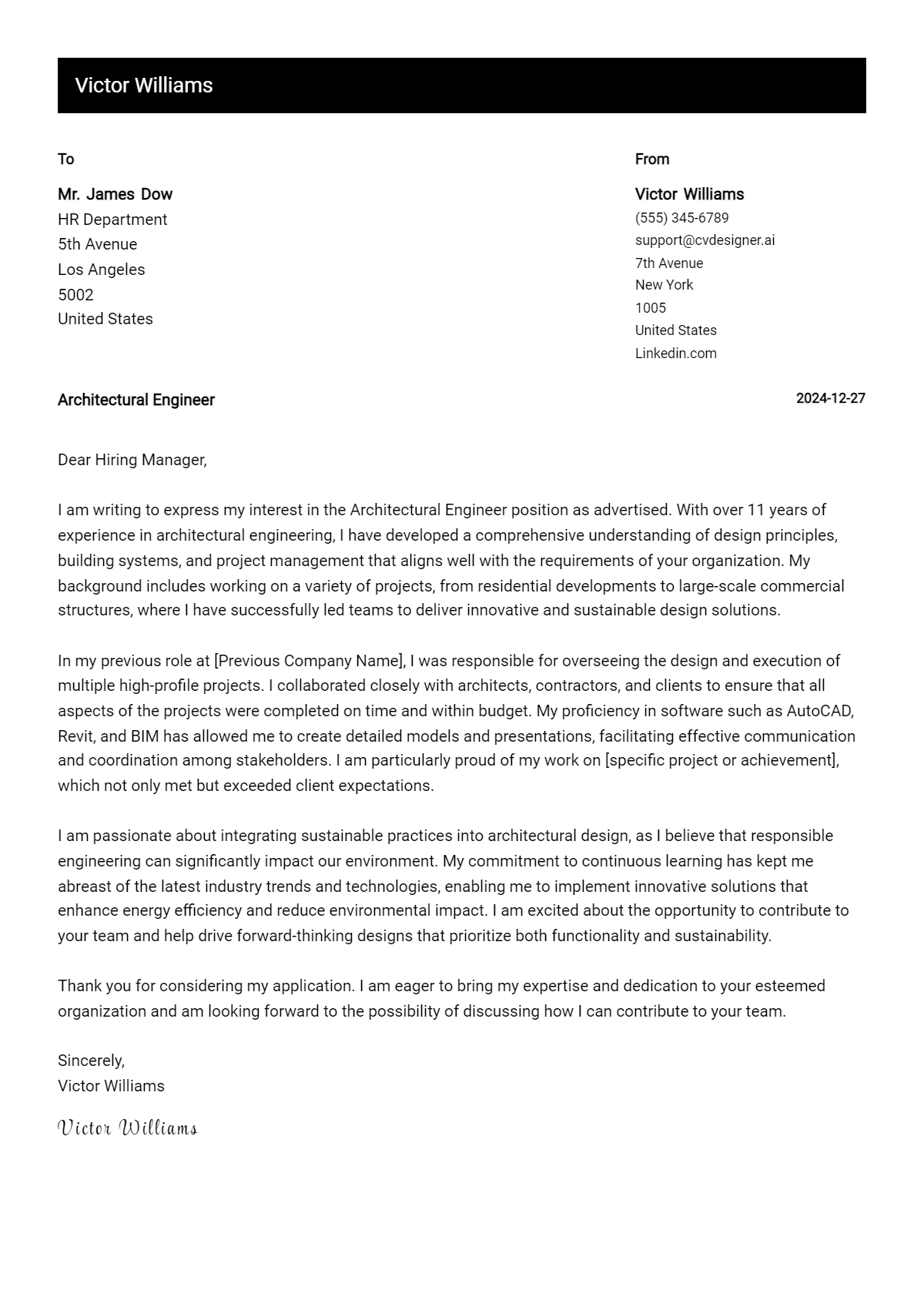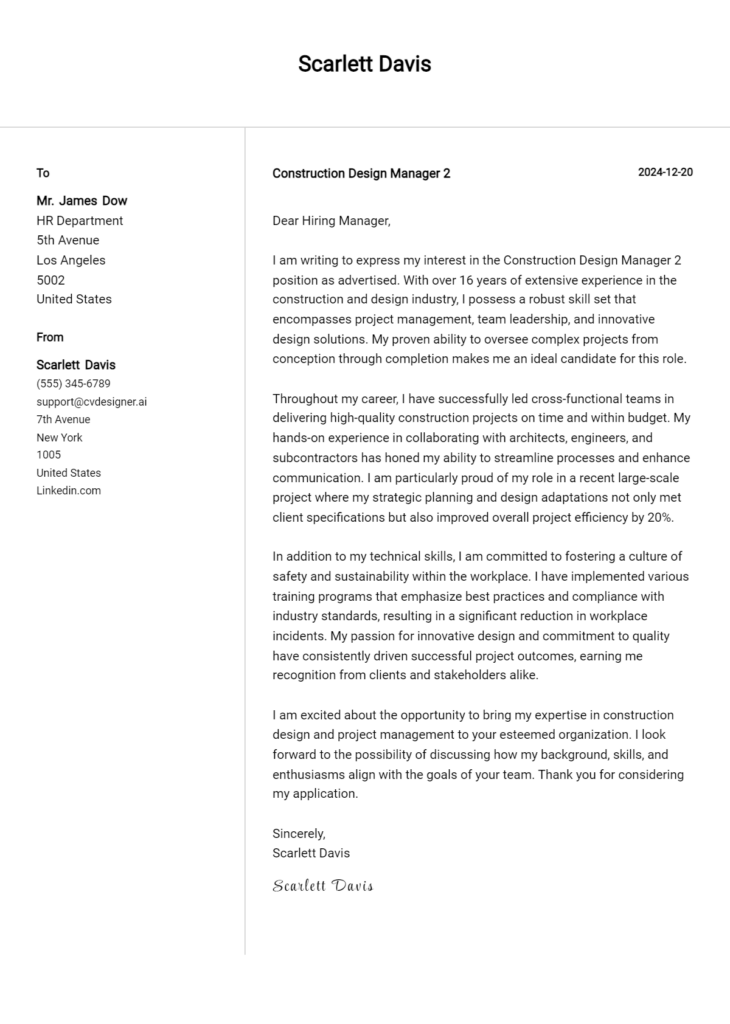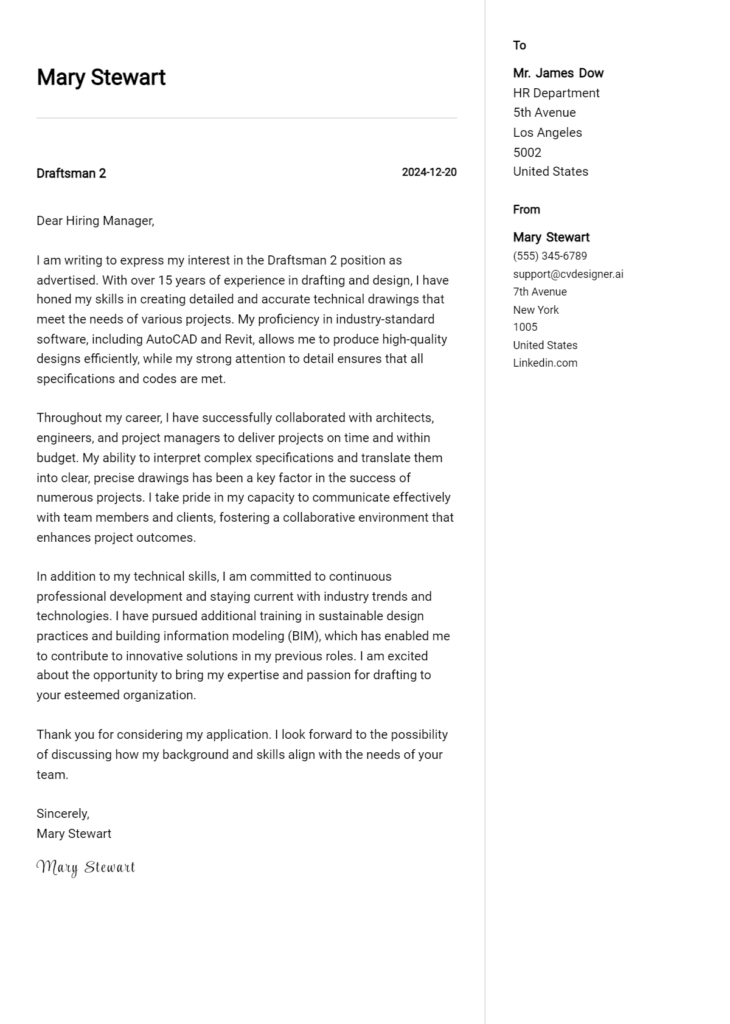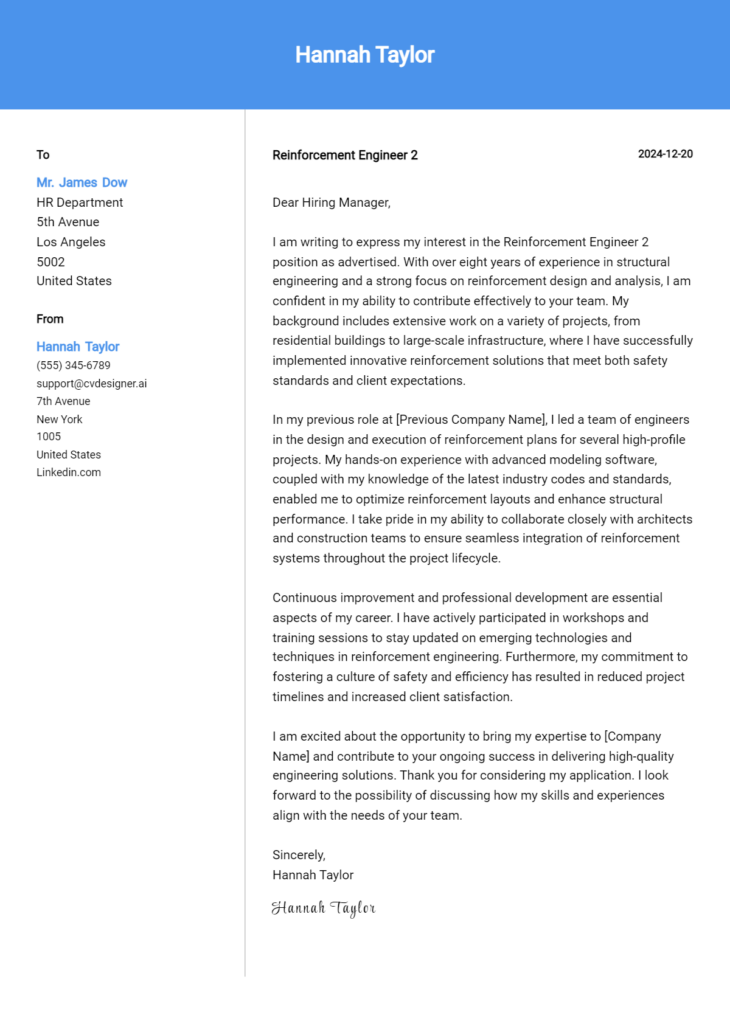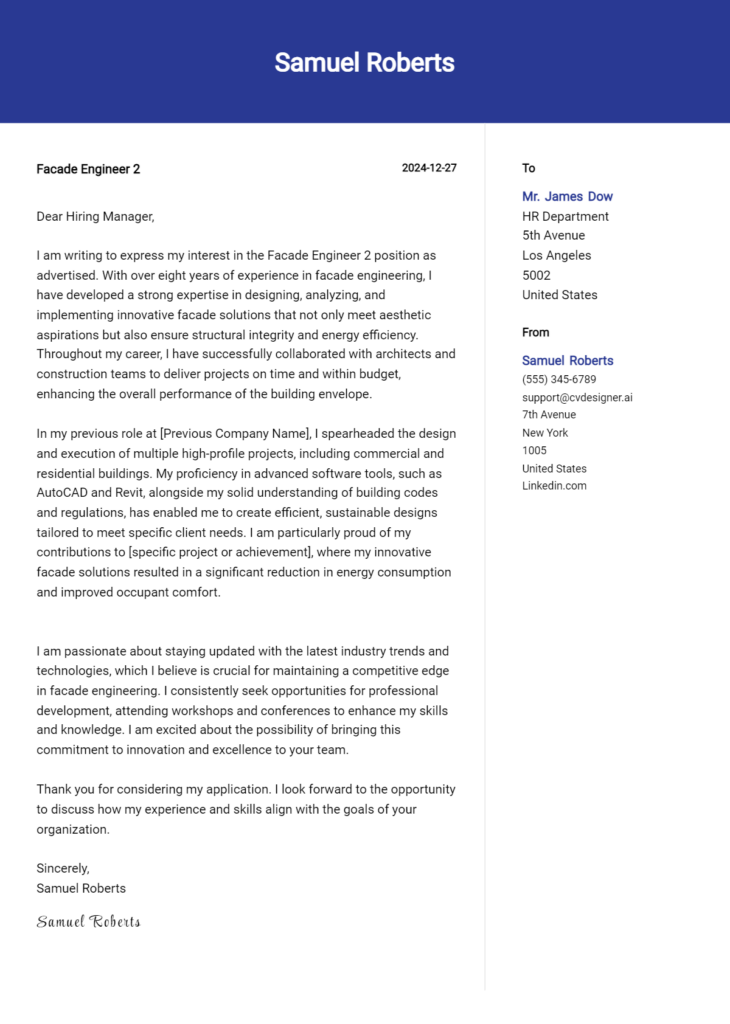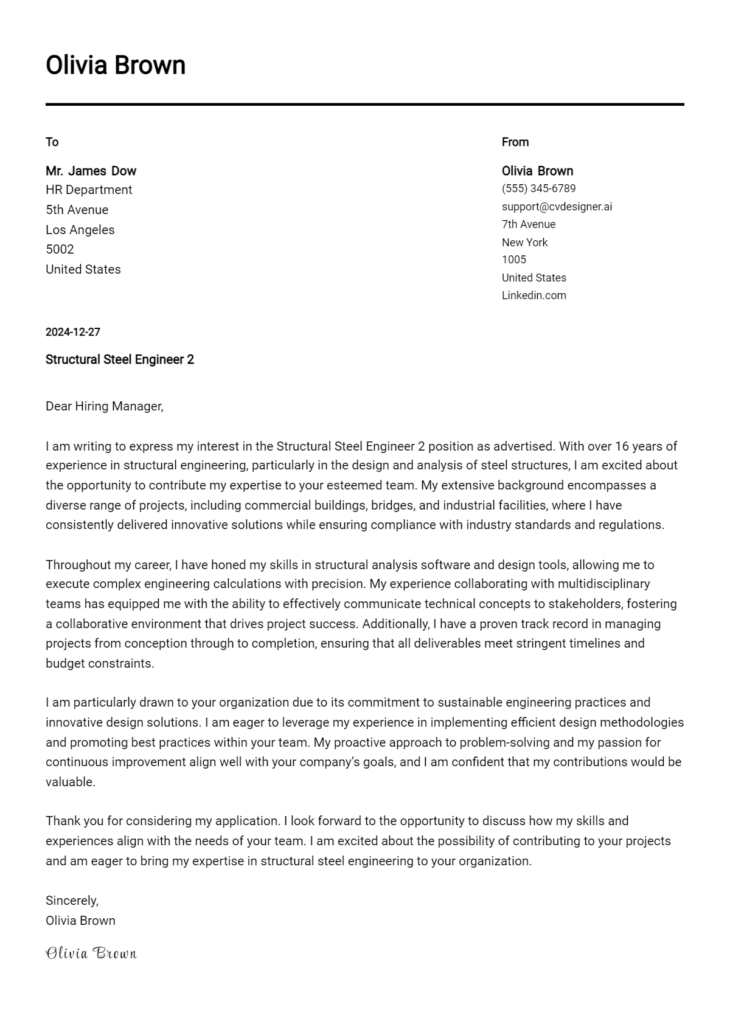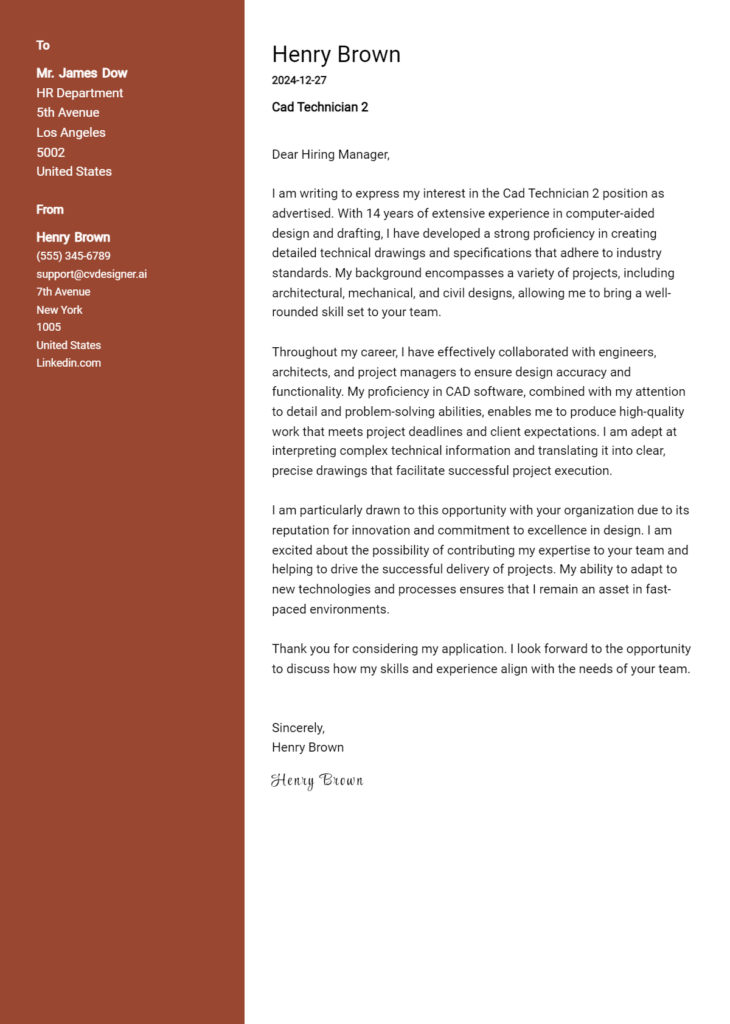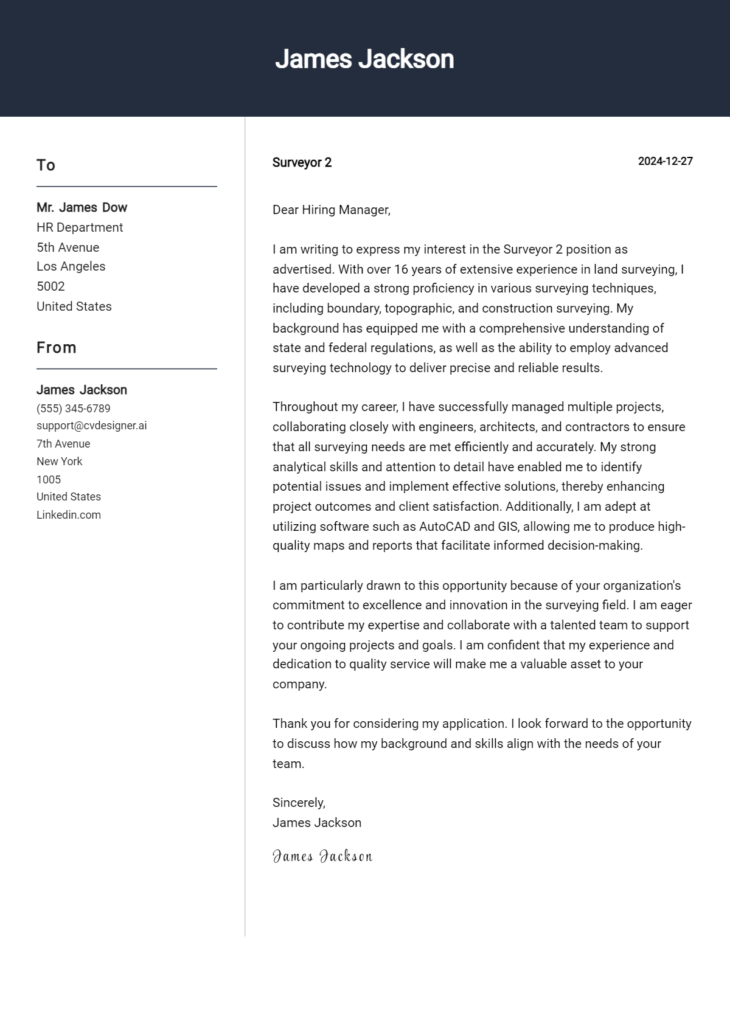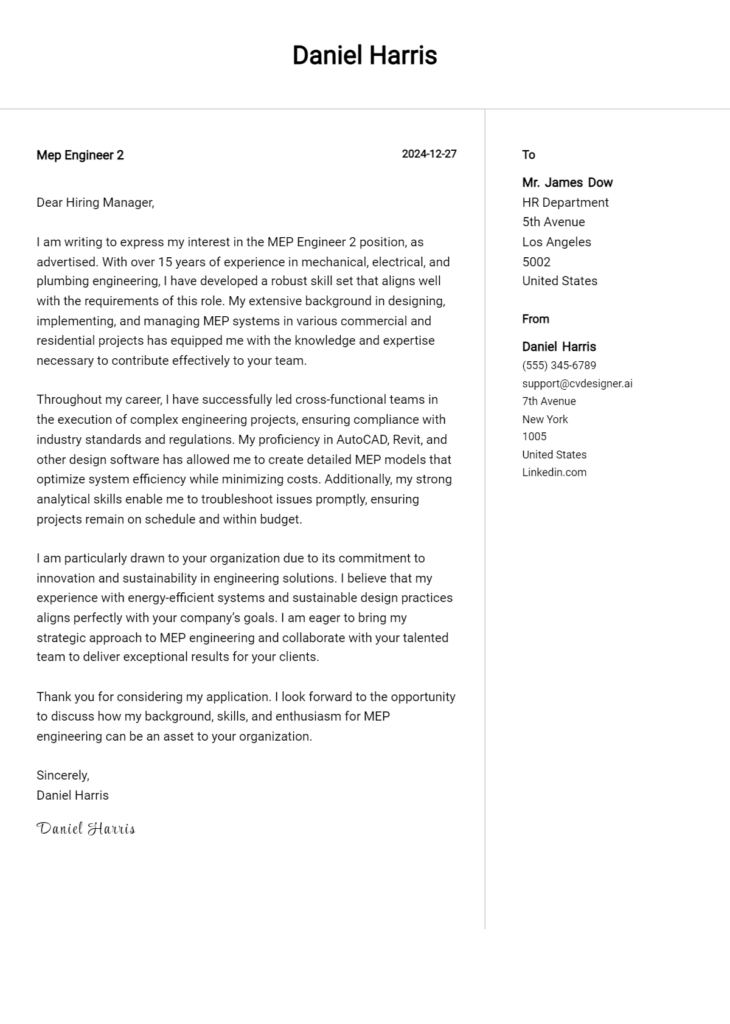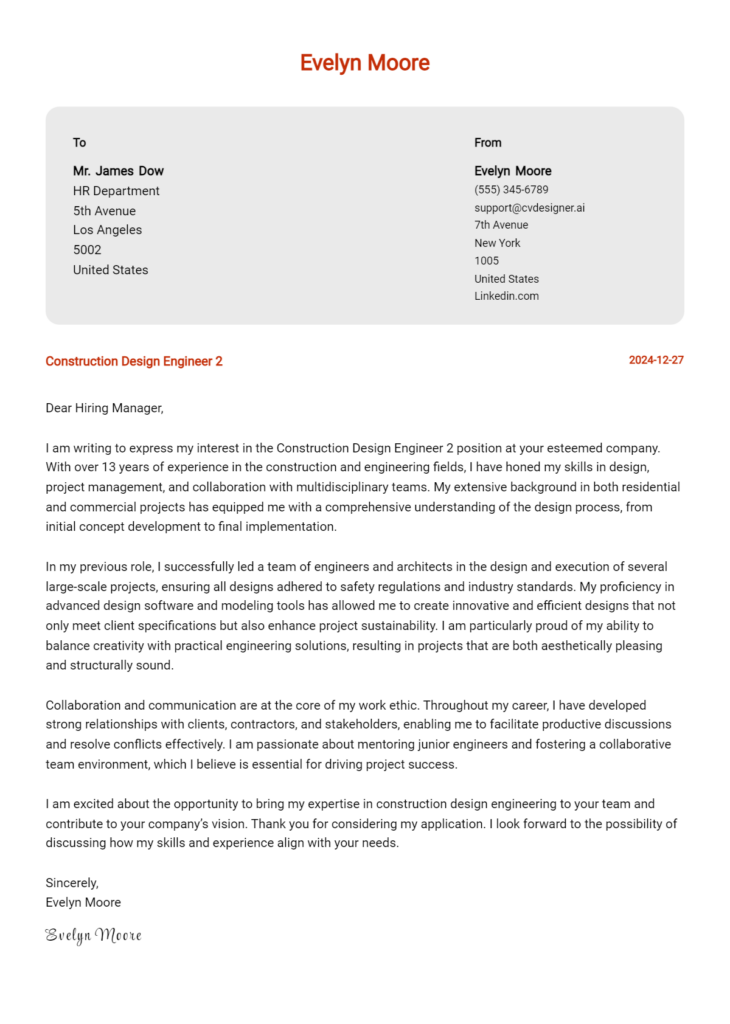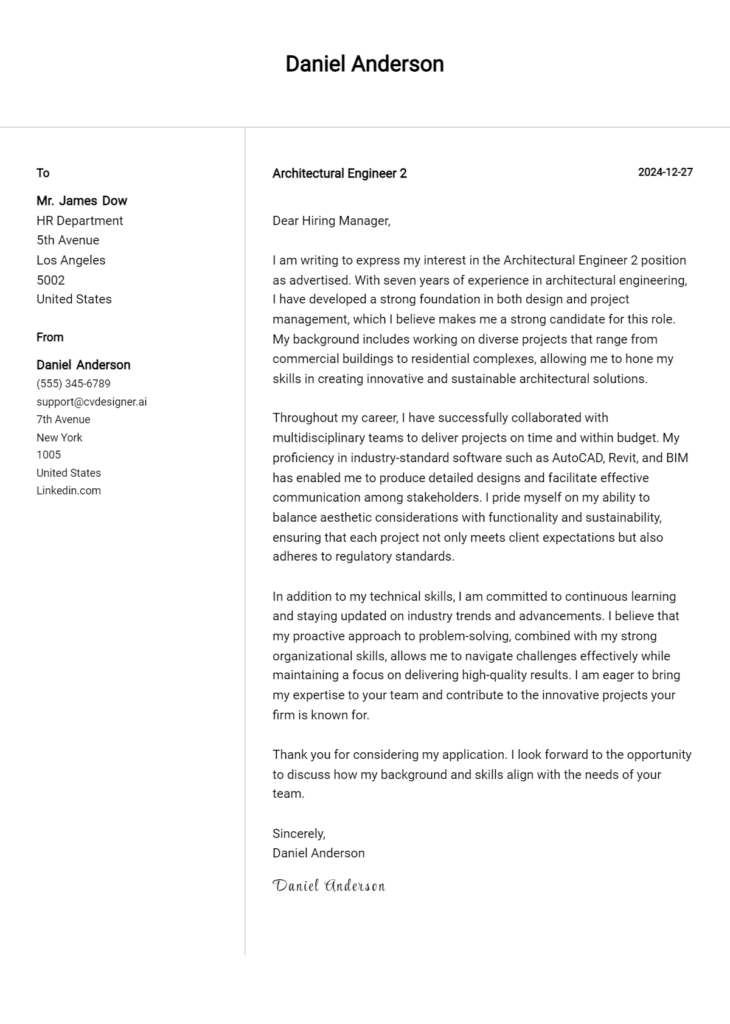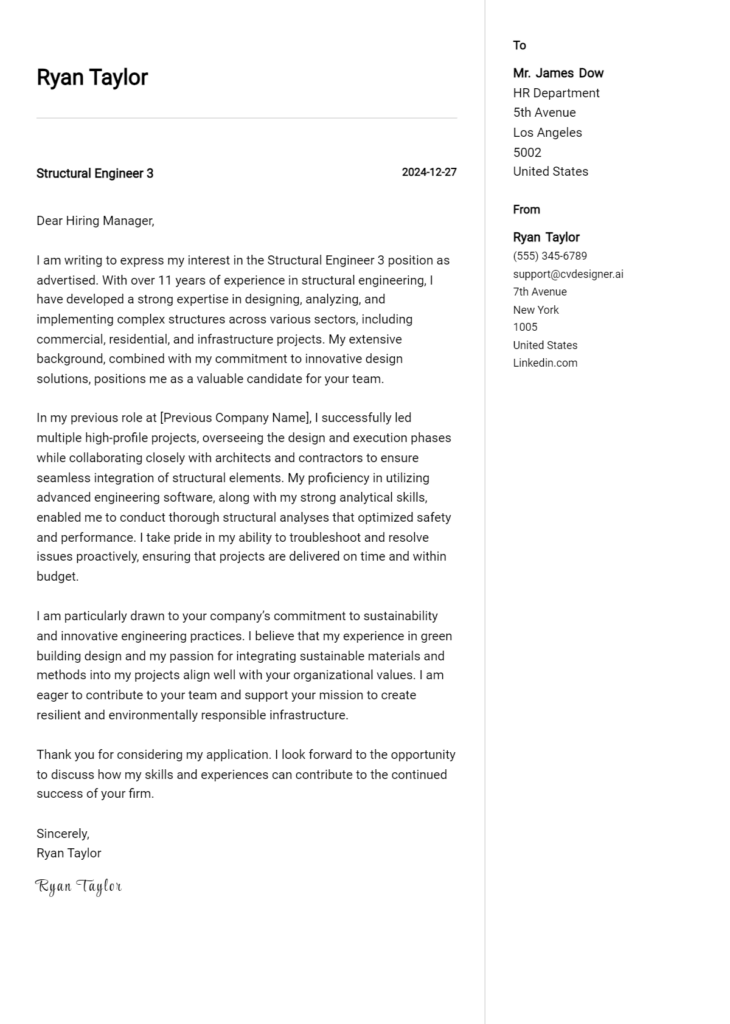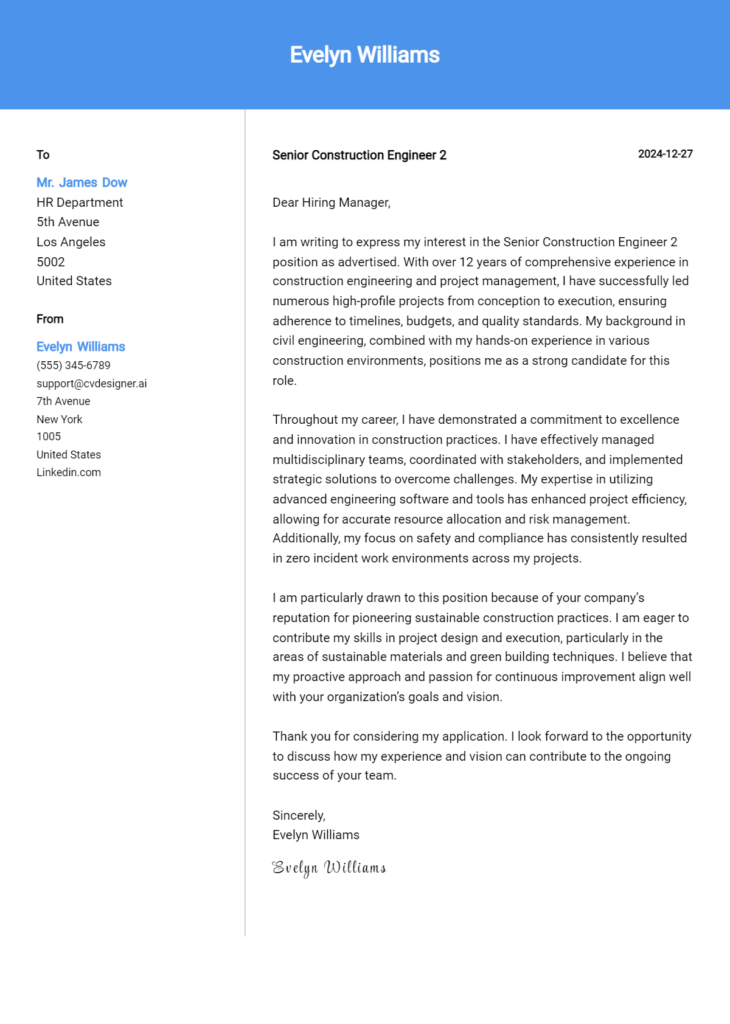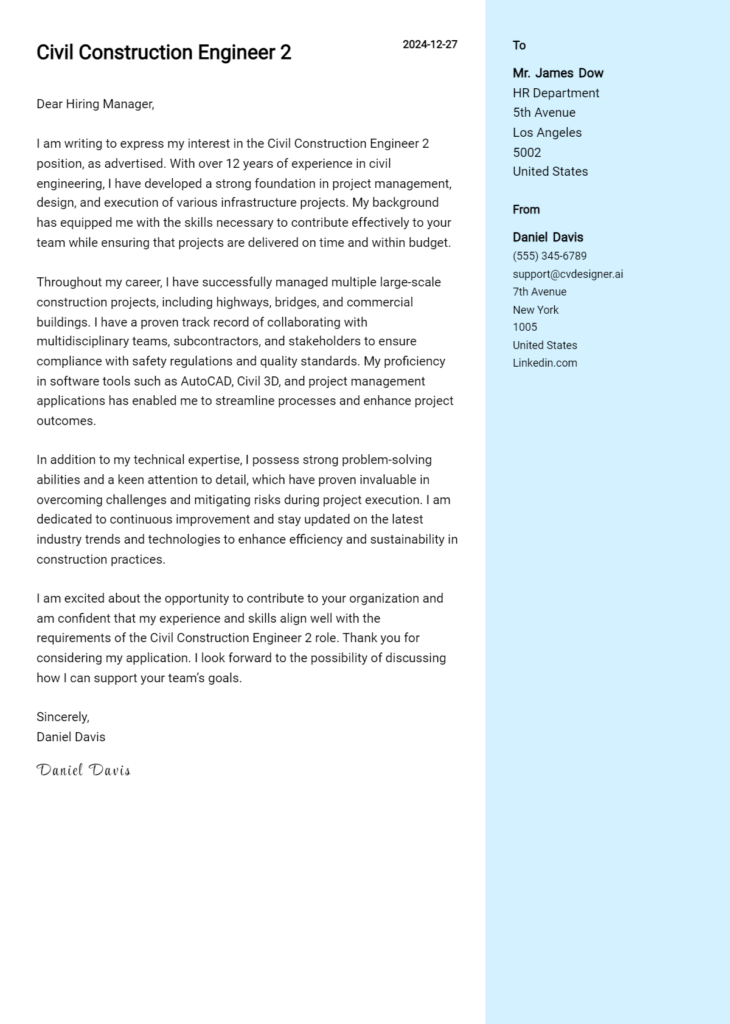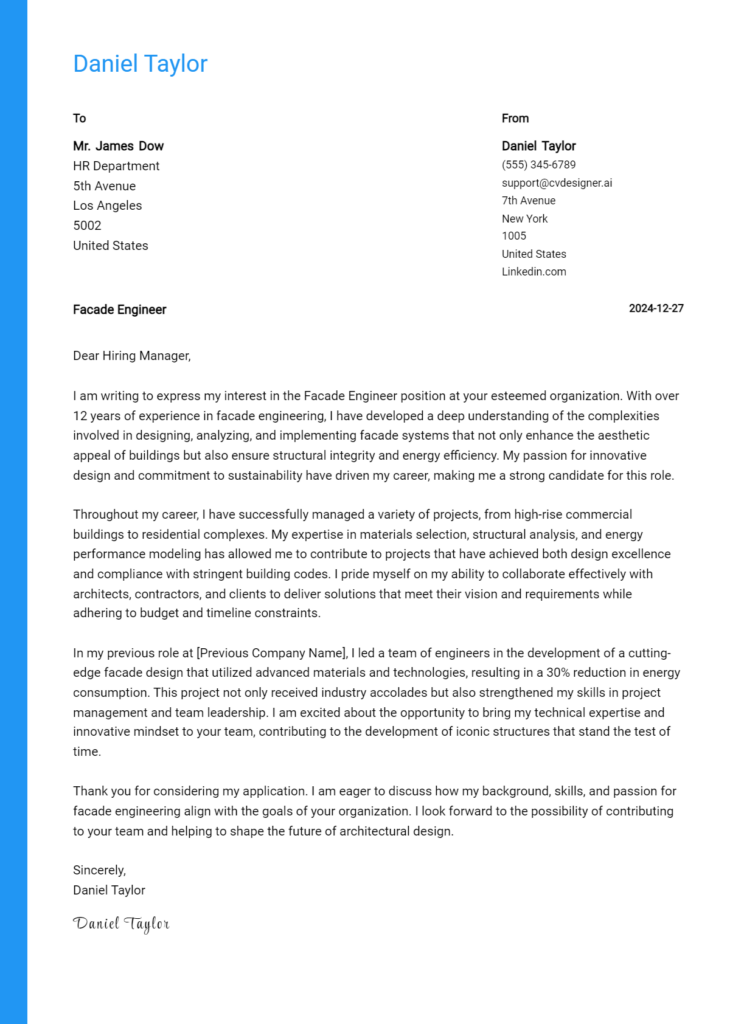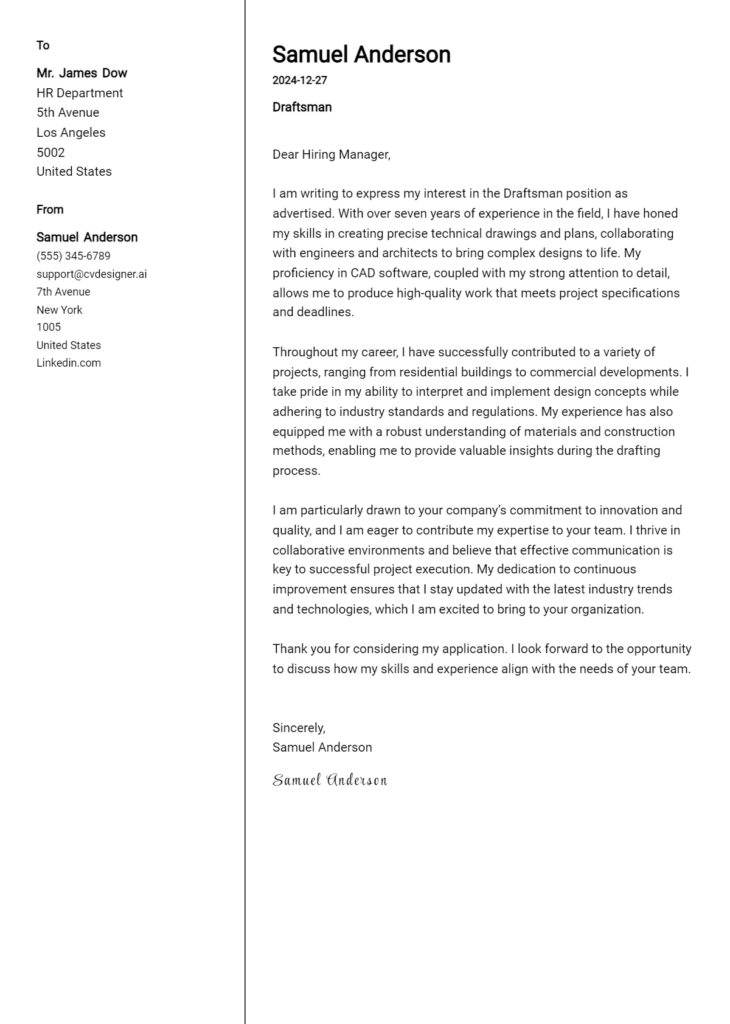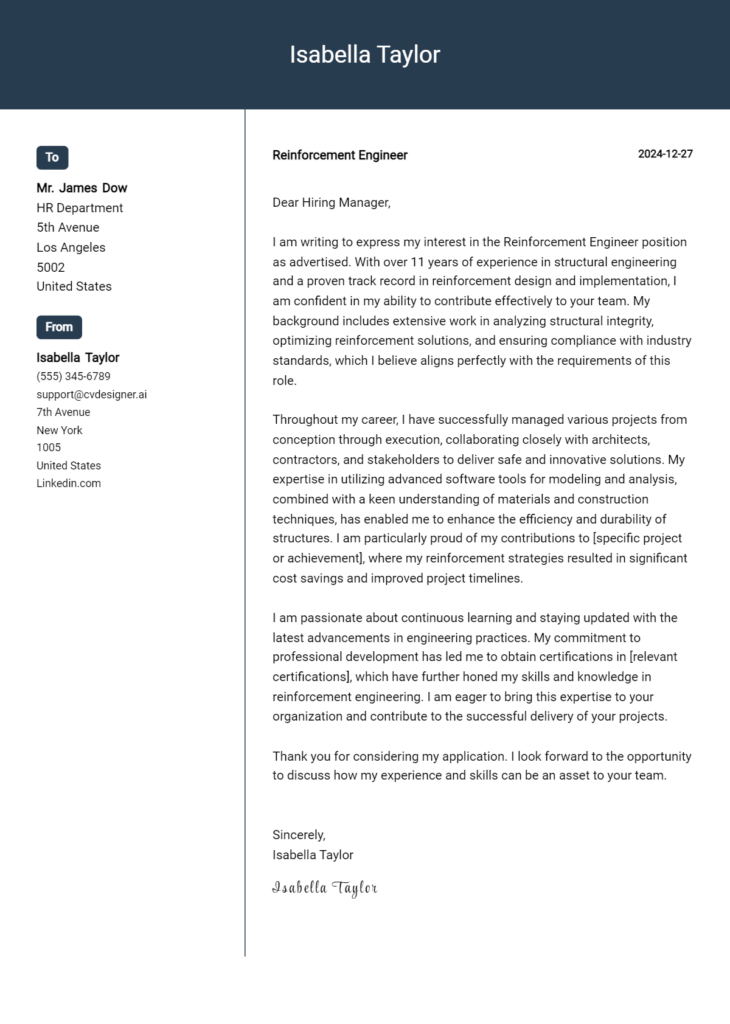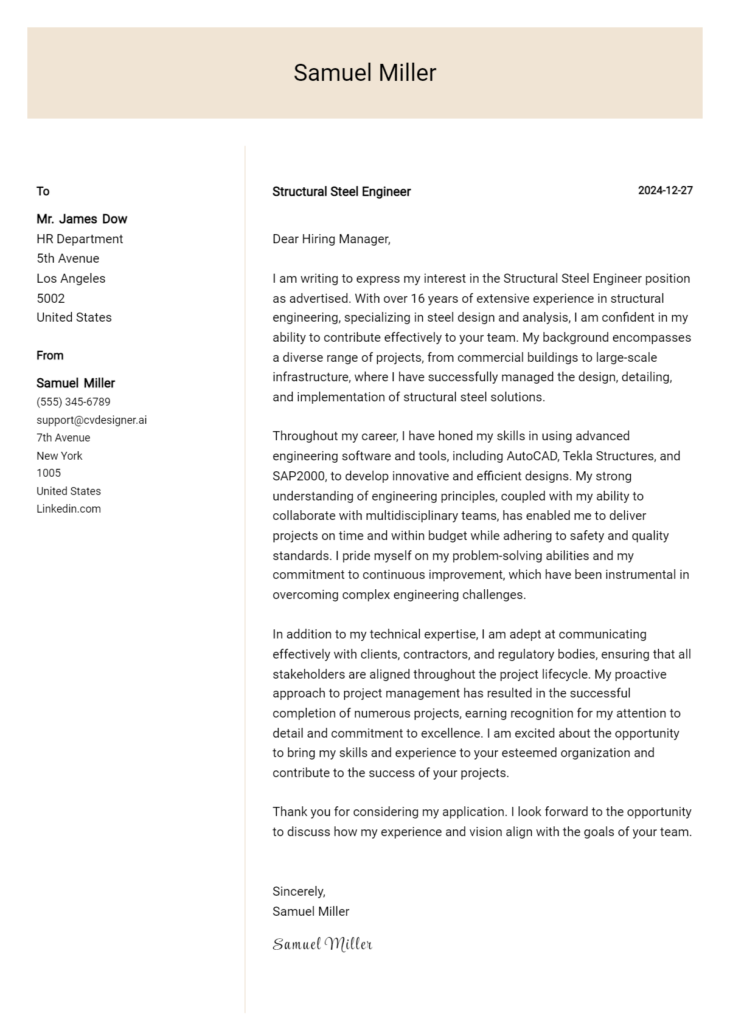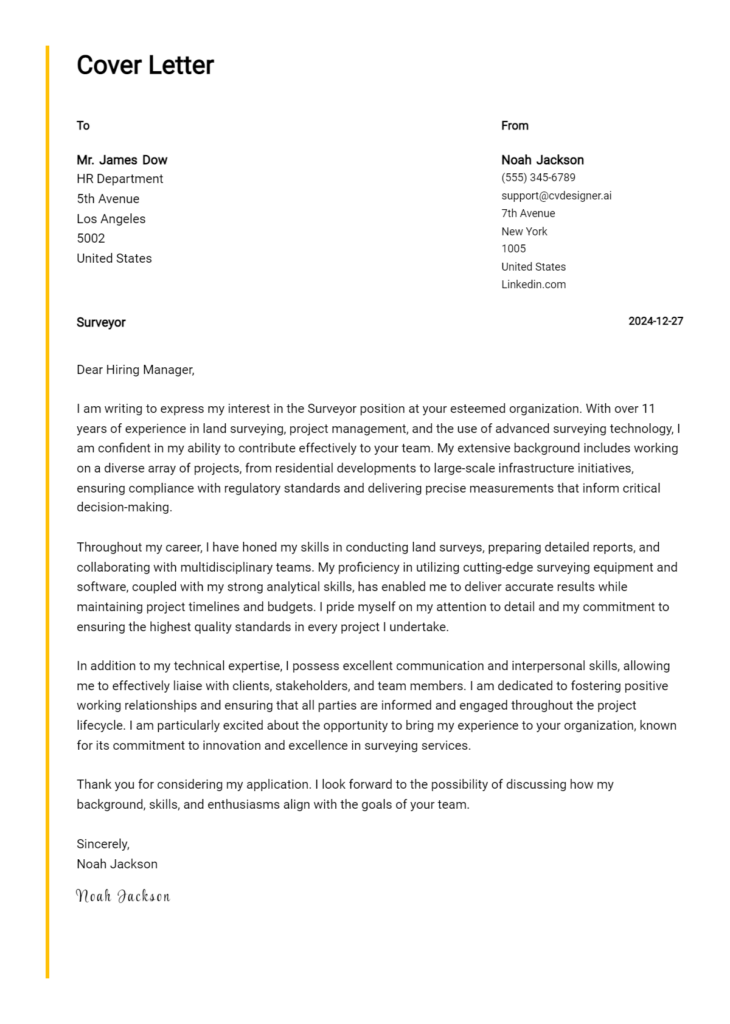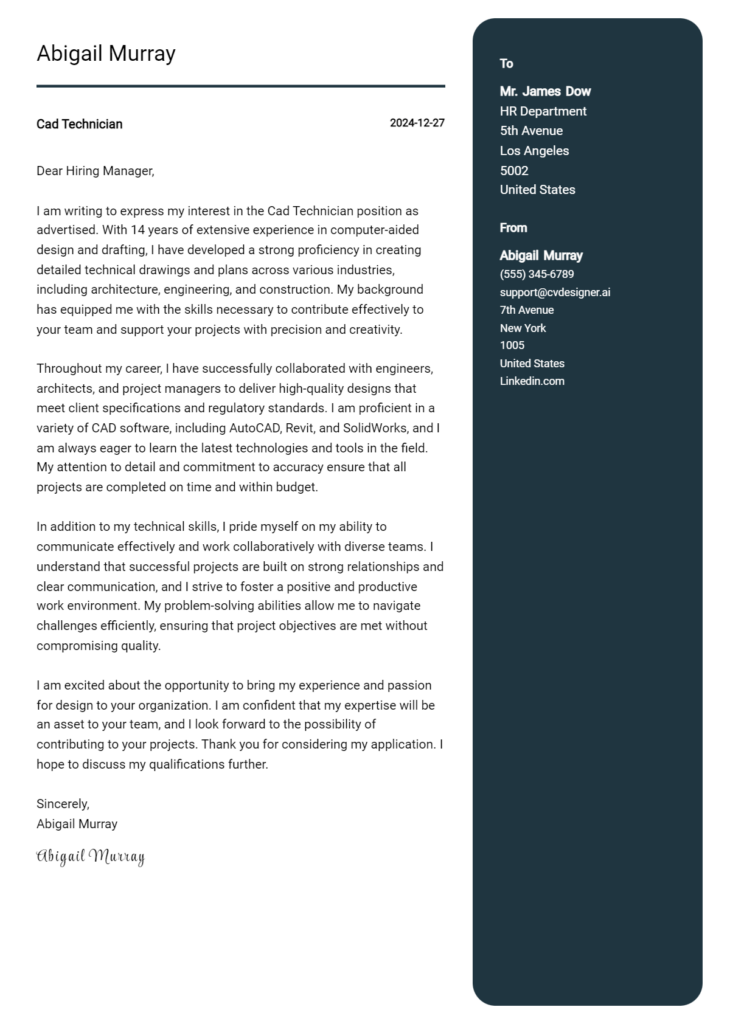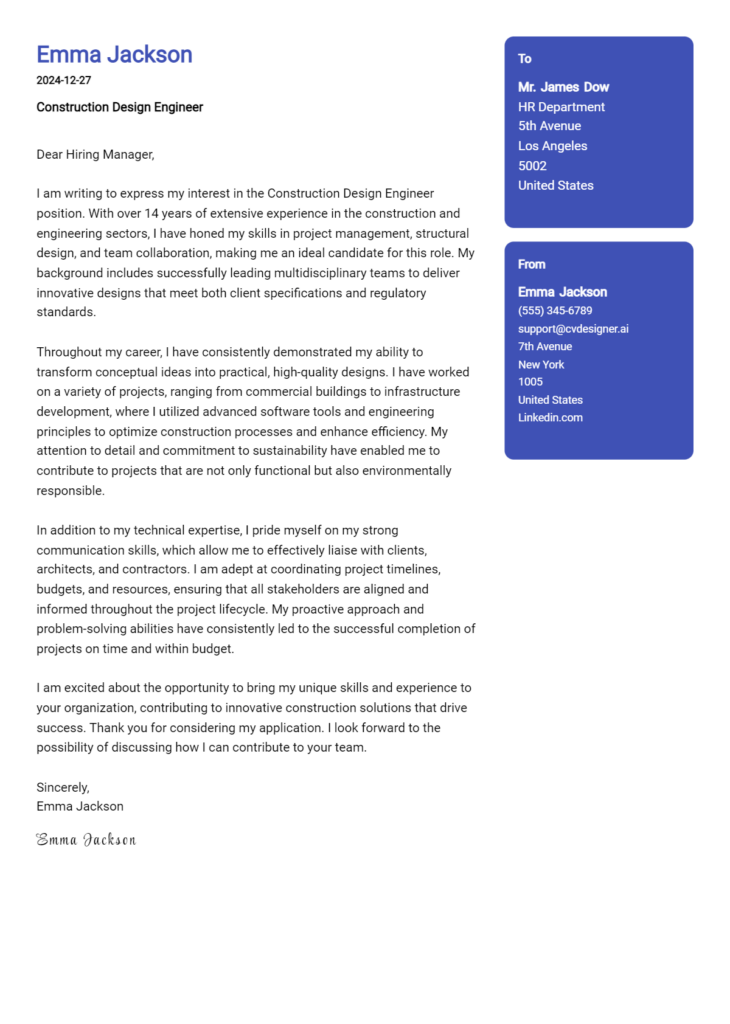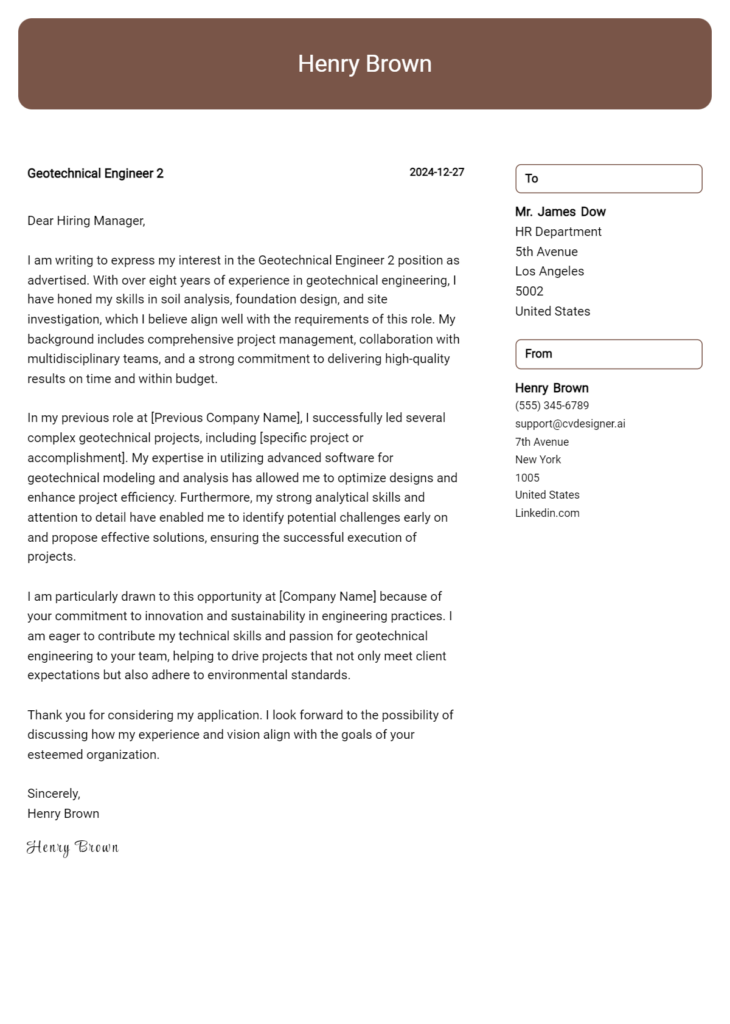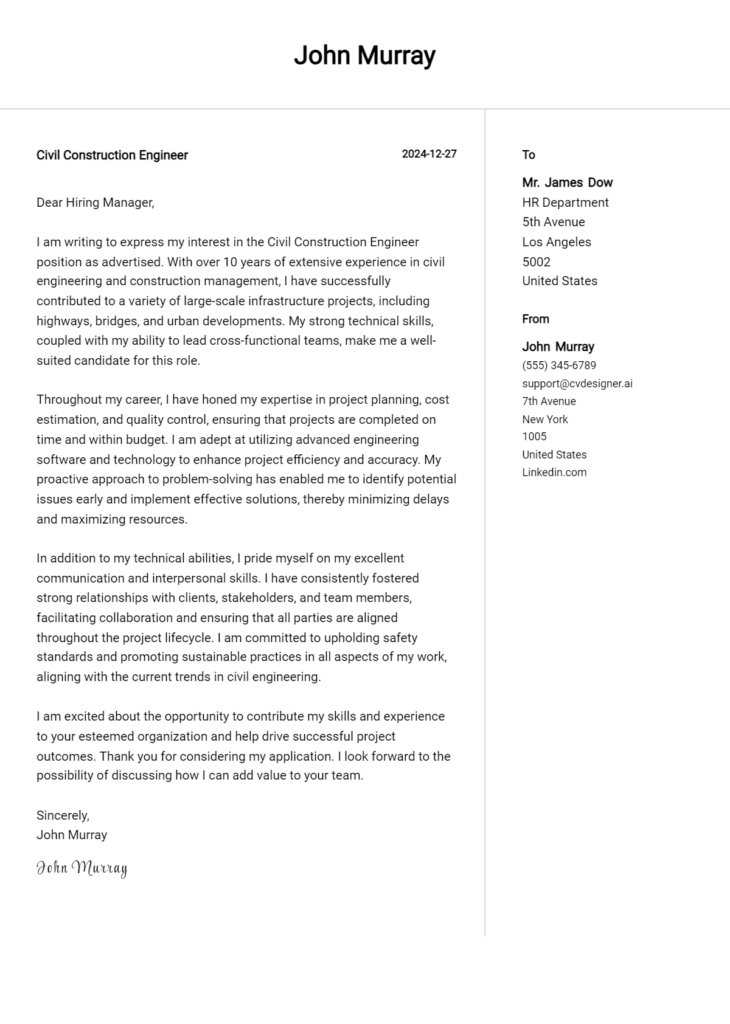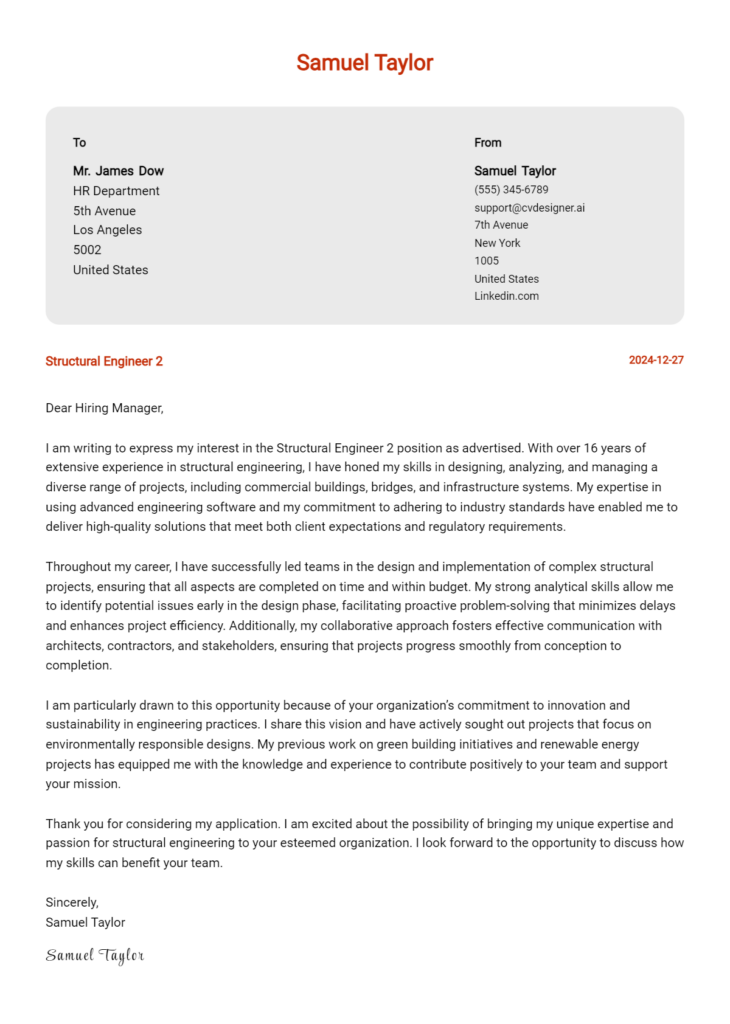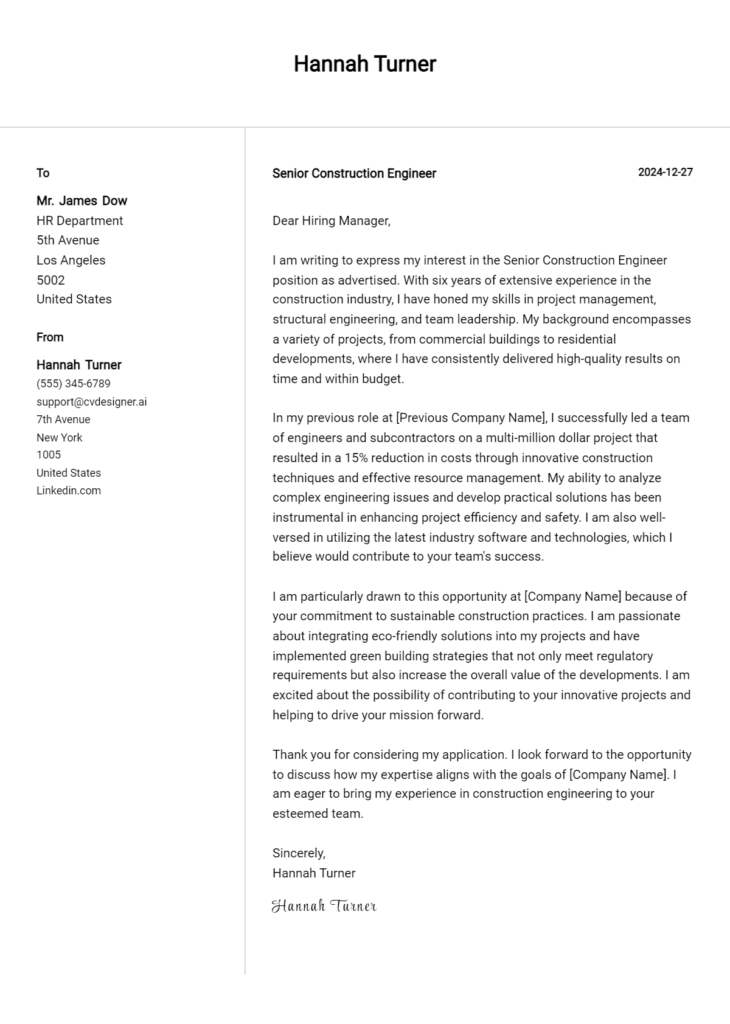Architectural Engineer Cover Letter Examples
Explore additional Architectural Engineer cover letter samples and guides and see what works for your level of experience or role.
How to Format an Architectural Engineer Cover Letter?
Crafting a compelling cover letter is essential for architectural engineers, as it serves as your first opportunity to convey your design expertise and technical proficiency. The way you format your cover letter not only reflects your attention to detail but also demonstrates your understanding of professional standards in architecture and engineering. A well-structured cover letter can effectively capture the hiring manager's interest, showcasing your skills in a clear and organized manner—key qualities for success in this field.
In this guide, we'll explore how to structure your cover letter, providing insights and architectural engineering-specific examples to help you create a persuasive document.
We'll focus on the essential components of a professional cover letter, including:
- Cover Letter Header
- Cover Letter Greeting
- Cover Letter Introduction
- Cover Letter Body
- Cover Letter Closing
Each section plays a crucial role in emphasizing your qualifications and professionalism. Let’s break down each part and discuss how to make your architectural engineer cover letter stand out.
The Importance of a Cover Letter Header for an Architectural Engineer
A well-structured cover letter header is crucial for an Architectural Engineer as it sets the tone for the entire application. It provides essential contact information and establishes a professional impression right from the start. A clear and organized header should include the applicant's name, address, phone number, and email address, followed by the date and the recipient's details (name, title, company, and address). This ensures that the hiring manager can easily contact the applicant and recognize the professionalism of the submission.
A strong header reflects attention to detail and respect for the recipient, while a weak one may leave the impression of carelessness. Here are examples of both:
Strong Example
John Smith 123 Architect Lane Cityville, ST 12345 (123) 456-7890 john.smith@email.com October 5, 2023 Ms. Jane Doe Hiring Manager Design Innovations Inc. 456 Design Blvd Cityville, ST 12345
Weak Example
john smith 123 architect lane october 5 jane doe design innovations
Importance of the Cover Letter Greeting
The greeting of your cover letter is crucial as it sets the tone for the entire document and serves as the first impression you make on the hiring manager. A well-crafted greeting demonstrates professionalism and a level of personalization that can differentiate you from other candidates. By addressing the hiring manager directly, you show that you have taken the time to research the company and the specific individual responsible for hiring, which reflects your genuine interest in the position. To avoid generic greetings that may come across as impersonal, it’s advisable to look up the recipient's name, either through the company website or professional networking sites like LinkedIn. This small but significant detail can enhance your cover letter's impact.
Strong Greeting Example
Dear Mr. Smith,
Weak Greeting Example
To Whom It May Concern,
The Importance of a Compelling Cover Letter Introduction for an Architectural Engineer
A well-crafted cover letter introduction is crucial for an Architectural Engineer as it serves as the first impression to the hiring manager. This opening paragraph should not only grab attention but also convey the candidate's enthusiasm for the position while highlighting relevant skills and accomplishments. An effective introduction sets the tone for the entire cover letter and can differentiate a candidate from the competition. Below are examples of both strong and weak introductions to illustrate how impactful this section can be.
Strong Example
Dear [Hiring Manager's Name], I am excited to apply for the Architectural Engineer position at [Company Name], as I have a profound passion for innovative design and sustainable architecture. With over five years of experience in delivering high-performance building solutions, I successfully led a team in the development of a LEED-certified commercial complex that reduced energy consumption by 30%. I am eager to bring my expertise in structural analysis and project management to your esteemed firm and contribute to your mission of creating environmentally responsible designs.
Weak Example
To Whom It May Concern, I am writing to apply for the Architectural Engineer job. I have some experience in the field and have worked on a few projects. I think I would be a good fit for the role because I can do the work required. Thank you for considering my application.
Purpose of the Cover Letter Body for an Architectural Engineer
The body of a cover letter for an Architectural Engineer serves as a critical platform for candidates to demonstrate their unique qualifications, relevant experiences, and the specific value they bring to a potential employer. This section allows applicants to highlight their technical skills and project management capabilities, as well as showcase significant accomplishments that align with the needs of the company. By detailing specific projects—such as successful building designs, sustainable practices implemented, or collaborative efforts in multidisciplinary teams—candidates can effectively convey their expertise and passion for architecture. A well-crafted cover letter body not only emphasizes qualifications but also illustrates how the candidate's vision and skills can contribute to the company’s goals.
Strong Example
Dear Hiring Manager, I am excited to apply for the Architectural Engineer position at XYZ Company. With over five years of experience in designing energy-efficient residential and commercial buildings, I have successfully led projects that reduced energy consumption by up to 30%. One of my notable achievements includes the design of the Green Tower, which received the LEED Platinum certification for its innovative use of sustainable materials and smart technologies. My strong background in structural analysis and proficiency in BIM software will enable me to contribute effectively to your team and support your commitment to sustainable architecture. Sincerely, John Doe
Weak Example
Dear Hiring Manager, I am writing to apply for the Architectural Engineer role. I have some experience in architecture and have worked on various projects. I believe I could do well at your company. My skills include working with design software and managing projects, but I don't have specific examples to share right now. I hope to bring my skills to your team. Best, Jane Smith
Importance of the Cover Letter Closing for an Architectural Engineer
The closing paragraph of a cover letter is crucial for leaving a lasting impression on the hiring manager. For an Architectural Engineer, it serves to summarize key qualifications, reiterate enthusiasm for the role, and encourage the next steps in the hiring process, such as reviewing the resume or scheduling an interview. A strong closing can reinforce your fit for the position and demonstrate your proactive approach, whereas a weak closing may fail to convey your seriousness about the opportunity.
Strong Example
Thank you for considering my application for the Architectural Engineer position at [Company Name]. With a robust background in sustainable design, project management, and a strong commitment to innovative architectural solutions, I am excited about the opportunity to contribute to your team. I look forward to discussing how my skills align with your goals and would appreciate the opportunity to further elaborate during an interview. Please feel free to contact me at your earliest convenience to schedule a meeting. Thank you once again for your time and consideration.
Weak Example
I hope you think my application is good. I really want this job because it seems interesting. If you want to talk to me, that would be nice. Thanks.
Crafting an effective cover letter is crucial for candidates aspiring to become Architectural Engineers. Your cover letter serves as a first impression, showcasing not only your technical skills but also your problem-solving abilities and understanding of the Software Development Life Cycle (SDLC). Additionally, highlighting your teamwork experience and passion for continuous learning can set you apart from other candidates. To help you create a compelling cover letter, here are some essential tips.
Tips for Writing a Cover Letter for Architectural Engineer
Highlight Technical Skills: Emphasize your expertise in architectural design software such as AutoCAD, Revit, or BIM. Provide specific examples of projects where you successfully applied these tools to enhance design efficiency or project outcomes. Mention any certifications or training you have completed that further validate your technical skill set.
Showcase Problem-Solving Abilities: Architectural engineering often involves complex challenges. Share a specific instance where you identified a problem during a project and describe the steps you took to resolve it. This could include innovative design solutions, budget management, or timeline adjustments that showcase your analytical thinking and resourcefulness.
Demonstrate SDLC Knowledge: Discuss your familiarity with the Software Development Life Cycle in the context of architectural engineering. Explain how you have utilized this knowledge to streamline processes, ensure quality control, or collaborate with cross-functional teams. This not only shows your technical acuity but also your ability to work effectively within a structured framework.
Emphasize Teamwork Experience: Architectural projects are rarely completed in isolation. Highlight your experience working in teams, focusing on your ability to communicate effectively with architects, engineers, and clients. Illustrate how your collaborative efforts contributed to the success of a project, showcasing your interpersonal skills and ability to work towards a common goal.
Express a Passion for Continuous Learning: The field of architectural engineering is constantly evolving with new technologies and methodologies. Mention any recent courses, workshops, or certifications you’ve pursued to stay current in the industry. This demonstrates your commitment to professional development and your proactive approach to enhancing your skill set.
By following these tips, you can create a strong cover letter that effectively presents your qualifications and enthusiasm for the role of Architectural Engineer. For more guidance, consider using cover letter templates or a cover letter builder to streamline the writing process.
Common Mistakes to Avoid in an Architectural Engineer Cover Letter
Crafting an effective cover letter is essential for making a strong impression in the competitive field of architectural engineering. Avoiding common mistakes can significantly enhance your chances of landing an interview. Here are some pitfalls to watch out for:
Generic Greetings: Using "To Whom It May Concern" can make your application feel impersonal. Instead, research the hiring manager's name and address them directly.
Lack of Specificity: Failing to tailor your cover letter to the specific position can weaken your application. Highlight relevant experience and skills that directly relate to the job description.
Overly Formal Language: While professionalism is key, overly stiff language can come off as insincere. Aim for a conversational tone that reflects your personality.
Neglecting Formatting: A cluttered or unorganized cover letter can distract from your content. Follow a clear cover letter format to ensure easy readability.
Excessive Length: A cover letter that is too long can lead to important points being overlooked. Aim for a concise layout, ideally no more than one page.
Rehashing Your Resume: Simply repeating what’s on your resume without adding new insights can bore the reader. Use your cover letter to tell a story or share experiences that showcase your passion and capabilities.
Typos and Errors: Spelling mistakes and grammatical errors can undermine your professionalism. Always proofread your cover letter, and consider using tools or asking a friend for a second opinion.
By steering clear of these common mistakes, you can create a compelling cover letter that stands out. For inspiration, check out these cover letter examples to help guide your writing process.
Cover Letter FAQs for Architectural Engineer
What should I include in my cover letter as an Architectural Engineer?
In your cover letter, you should include a compelling introduction that outlines your interest in the position and the organization. Highlight your relevant qualifications, such as your degree in architectural engineering, certifications, and any specialized training. Discuss your professional experience, focusing on specific projects where you've made significant contributions, such as sustainable design or innovative structural solutions. Additionally, mention your proficiency with design software, project management tools, and your ability to collaborate with multidisciplinary teams. Conclude with a strong closing statement that reiterates your enthusiasm for the role and a call to action, inviting the hiring manager to discuss your application further.
How can I demonstrate my technical skills in my cover letter?
To effectively demonstrate your technical skills in your cover letter, integrate specific examples from your previous work experience. For instance, mention projects where you applied your knowledge of building codes, energy-efficient systems, or structural analysis. Use quantifiable metrics to illustrate your impact, such as how your designs improved energy efficiency by a certain percentage or reduced costs by a specific amount. Additionally, reference software proficiency, like AutoCAD, Revit, or BIM technologies, and explain how you utilized these tools in project execution. This approach not only showcases your skills but also provides evidence of your capabilities and contributions to past employers.
How can I tailor my cover letter for a specific job application?
To tailor your cover letter for a specific job application, start by thoroughly researching the company and the role. Identify the key requirements and responsibilities outlined in the job description. Use this information to adjust your cover letter, emphasizing the skills and experiences that align with the position. For example, if the job focuses on sustainable design, highlight your experience with green building projects and relevant certifications. Additionally, mention the company's recent projects or values to demonstrate your understanding of their goals and culture. Personalizing your cover letter in this way shows genuine interest and helps you stand out from other candidates.
How can I effectively convey my passion for architectural engineering in my cover letter?
To convey your passion for architectural engineering in your cover letter, share a personal story or experience that ignited your interest in the field. For example, discuss a formative project you worked on during your studies or an inspiring mentor who influenced your career path. Additionally, express your commitment to the profession by mentioning any relevant associations or continuing education courses you've pursued. Highlight how your passion drives you to stay updated with industry trends and innovations, such as sustainable practices or advanced technologies. This narrative not only makes your cover letter more engaging but also helps potential employers see your enthusiasm and dedication to the field.
Build your Cover Letter in minutes
Use an AI-powered cover letter builder and have your letter done in 5 minutes. Just select your template and our software will guide you through the process.

